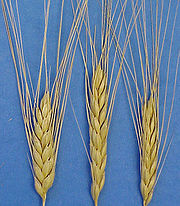
Mola salsa
Encyclopedia

Religion in ancient Rome
Religion in ancient Rome encompassed the religious beliefs and cult practices regarded by the Romans as indigenous and central to their identity as a people, as well as the various and many cults imported from other peoples brought under Roman rule. Romans thus offered cult to innumerable deities...
, mola salsa ("salted flour") was a mixture of coarse
Granularity
Granularity is the extent to which a system is broken down into small parts, either the system itself or its description or observation. It is the "extent to which a larger entity is subdivided...
-ground, toasted emmer
Emmer
Emmer wheat , also known as farro especially in Italy, is a low yielding, awned wheat. It was one of the first crops domesticated in the Near East...
flour
Flour
Flour is a powder which is made by grinding cereal grains, other seeds or roots . It is the main ingredient of bread, which is a staple food for many cultures, making the availability of adequate supplies of flour a major economic and political issue at various times throughout history...
and salt
Salt
In chemistry, salts are ionic compounds that result from the neutralization reaction of an acid and a base. They are composed of cations and anions so that the product is electrically neutral...
prepared by the Vestal Virgin
Vestal Virgin
In ancient Roman religion, the Vestals or Vestal Virgins , were priestesses of Vesta, goddess of the hearth. The College of the Vestals and its well-being was regarded as fundamental to the continuance and security of Rome, as embodied by their cultivation of the sacred fire that could not be...
s and used in every official sacrifice. It was sprinkled on the forehead and between the horns of animal victims
Animal sacrifice
Animal sacrifice is the ritual killing of an animal as part of a religion. It is practised by many religions as a means of appeasing a god or gods or changing the course of nature...
before they were sacrificed, as well as on the altar and in the sacred fire
Sacred fire of Vesta
The sacred fire of Vesta was a holy fire in Ancient Rome. The Vestal Virgins were selected by lot and served for thirty years, tending the holy fire and performing other rituals connected to domestic life—among them were the ritual sweeping of the temple on June 15 and the preparation of...
. It was a common offering to the household hearth
Hearth
In common historic and modern usage, a hearth is a brick- or stone-lined fireplace or oven often used for cooking and/or heating. For centuries, the hearth was considered an integral part of a home, often its central or most important feature...
.
Servius describes the substance as pius (perhaps "reverently prepared" in this sense) and castus ("ritually pure"). The mola salsa was so fundamental to sacrifice that "to put on the mola" (Latin immolare) came to mean "to sacrifice," hence English "immolation." Its use was one of the numerous religious traditions ascribed to Numa Pompilius
Numa Pompilius
Numa Pompilius was the legendary second king of Rome, succeeding Romulus. What tales are descended to us about him come from Valerius Antias, an author from the early part of the 1st century BC known through limited mentions of later authors , Dionysius of Halicarnassus circa 60BC-...
, the Sabine
Sabine
The Sabines were an Italic tribe that lived in the central Appennines of ancient Italy, also inhabiting Latium north of the Anio before the founding of Rome...
second king of Rome
King of Rome
The King of Rome was the chief magistrate of the Roman Kingdom. According to legend, the first king of Rome was Romulus, who founded the city in 753 BC upon the Palatine Hill. Seven legendary kings are said to have ruled Rome until 509 BC, when the last king was overthrown. These kings ruled for...
.
The College
Collegium (ancient Rome)
In Ancient Rome, a collegium was any association with a legal personality. Such associations had various functions.-Functioning:...
of Vestals would make mola salsa during the Vestalia, the chief festival
Roman festivals
In ancient Roman religion, holidays were celebrated to worship and celebrate a certain god or divine event, and consisted of religious observances and festival traditions, usually with a large feast, and often featuring games . The most important festivals were the Saturnalia, the Consualia, the...
of the hearth goddess Vesta
Vesta (mythology)
Vesta was the virgin goddess of the hearth, home, and family in Roman religion. Vesta's presence was symbolized by the sacred fire that burned at her hearth and temples...
celebrated June 7–15.

